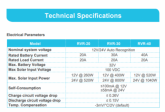My system is in a 2-3 season cabin in the woods. When I'm not there, I really want to make sure things are safe.
Basically, I have a controller that connects to (1) solar panels (2) batteries. Diagram is below (by the way, any feedback on my wiring and fusing appreciated!). My plan is to add the ability to cut off the panels and the batteries. Then there's no power coming into the wiring or appliances, so it should be safe, right?
Here's the question: if I just cut off the positive or negative wires, is that enough? or do I need to fully cut both + and - to fully deaden the circuits? I want this to be simple, yet fully 100% safe. I'd hate to cut just one line, then have a mouse short out a wire and ground something, allowing current to flow. But maybe I'm off base.
thanks.

Basically, I have a controller that connects to (1) solar panels (2) batteries. Diagram is below (by the way, any feedback on my wiring and fusing appreciated!). My plan is to add the ability to cut off the panels and the batteries. Then there's no power coming into the wiring or appliances, so it should be safe, right?
Here's the question: if I just cut off the positive or negative wires, is that enough? or do I need to fully cut both + and - to fully deaden the circuits? I want this to be simple, yet fully 100% safe. I'd hate to cut just one line, then have a mouse short out a wire and ground something, allowing current to flow. But maybe I'm off base.
thanks.




